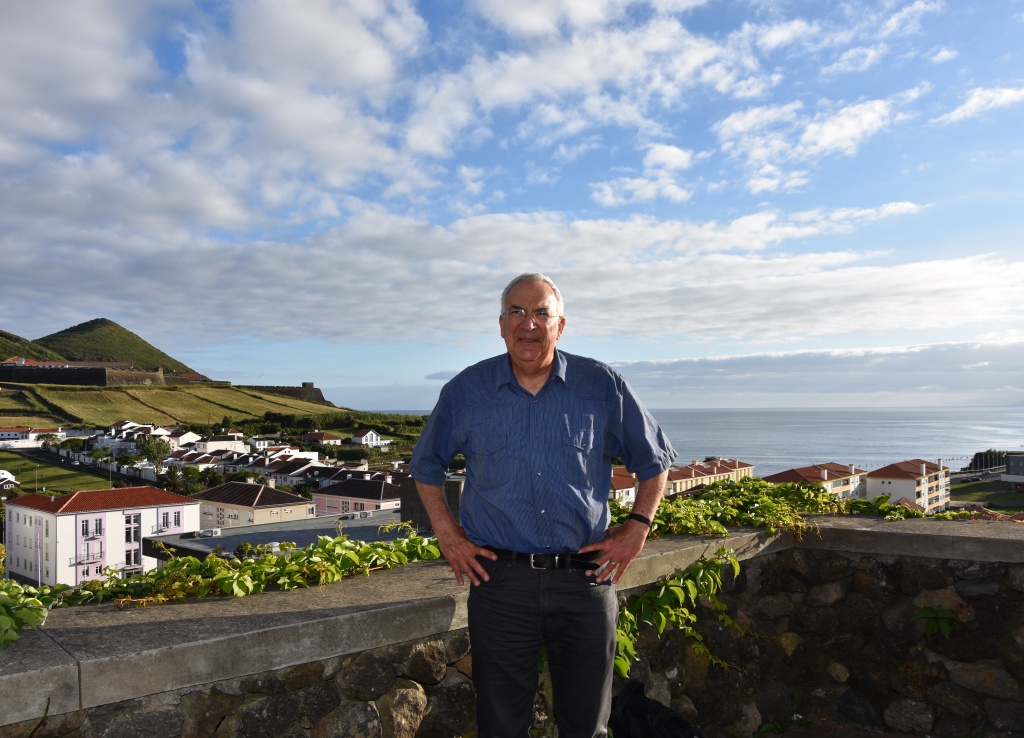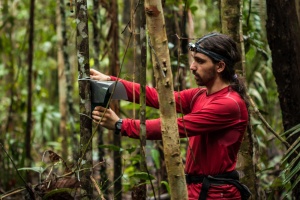2/09/2016. Interview by Marta Daniela Santos.
What happens when a species is introduced in an area outside its geographic range? What are the impacts on the existing community? How can these invasions be managed? These are a few of the several questions in which Daniel Simberloff currently works and which characterize the recent research field of Invasion Biology.
Currently Gore Professor of Environmental Science at the University of Tennessee (USA), Daniel Simberloff’s research spans areas such as Ecology, Evolution, Conservation Biology and Biogeography, to mention just a few.
In this interview, Daniel Simberloff talks about his research fields and his scientific passions: not only Biology, which fascinates him since he was a little boy collecting insects in cigar boxes, but also Mathematics – an area in which he considered graduating, before taking a Biology course for non-majors that made him change his mind.
Invasion biology is one of your current main research interests. What really defines an invasive species?
First of all, it's not just any non-native species. It has to be a non-native species that persists without human help and spreads into a more or less natural environment. It doesn't have to cause damage. Probably it does, because it's hard to imagine how it will get in that new environment and not affect some other species, but the damage isn't part of the definition. The definition is non-native, survives on its own without further help from humans in more or less natural environments.
And how did the ever faster and longer range means of transportation in the last few centuries - sailing ships, then trains and then air travel - affect biological invasions and the way they are studied?
Biological invasions were dramatically affected. In the era of sailing ships, if we're talking about terrestrial species like terrestrial plants or animals, it had to be something that could live on boats somehow, for thirty days or even longer. For example, in North America almost all of the earliest introduced species that eventually became invasive were plants and soil insects that live in the vicinity of Land's End, England. It's called Land's End because it's the last piece of land in Southwest England. Boats would stop there before they would start to cross the Atlantic to pick up soil for ballast, because they were going to the Americas to bring back timber. And the soil had plants and insects that could survive the thirty or so days.
Then in the 19th century finally there were steam ships, much faster, that brought a whole flood of other species. For example people were transporting ornamental plants - some of which became invasive - and the insects that lived on those plants. And they could get there much more quickly than one month on a ship.
Air travel, of course, is almost not a problem for anything. There's another issue, though: if you move a species from the northern to the southern hemisphere very quickly, you're taking it from its own winter, for example, into the austral summer. It may not be adapted. But it certainly has greatly facilitated the movement of species all over the globe.
Now, as for the study of invasions...there was no study of invasions until the 20th century, and actually very little until the mid-20th century. For example, the first scientific record of invasive species was by a Swedish Finn named Pehr Kalm, who was sent by [Carl] Linnaeus to the New World just to see what was there. And he recognized hundreds of things: for example, he saw fifteen plants that he knew to be European, and he gathered that they were introduced. He didn't talk about impact, he just noted they were there. And then in the 19th century there was the age of exploration; they would often send natural explorers, especially the British, called Victorian naturalists. They were the ones that sort of established the biogeography of the Earth, which species are where, beginning in the early 19th century. Among them was for example a man named Hewett Watson, who produced one of the earliest category classifications of species as native or introduced.
But...it's interesting. Of all these really remarkable scientists, many of them noted introduced species, but only two suggested that there was an impact: Charles Darwin and Alfred Russel Wallace. Darwin talks in several places about introduced species and how they have a huge impact. And Wallace noticed tremendous impacts of introduced species on islands. But they were the only ones, and that was before there was even a science of Ecology. The term Ecology was invented by a German in the 19th century, but there wasn't substantial ecological research on plants until the very early 20th century, and of animals until the late 1920s.
So even though those two, and only those two, noticed the impact, it didn't lead to the study of biological invasions. Even in the 20th century people occasionaly wouldn't notice it. Probably the greatest, most comprehensive treatment was by a man named [George M.] Thomson, who in the 1920s wrote a whole book on introduced plants and animals in New Zealand [The Naturalisation of Animals and Plants in New Zealand, 1922], where he talked about which species were where, about impact... But it was too early! [laughs]
It's often said that the field was founded in 1958, in a classic book by Charles Elton entitled The Ecology of Invasions by Animals and Plants. But it wasn't! It's a great book, he raised almost all the problems we study nowadays, but it didn't lead to sustained study. People did study introduced species that were highly problematic, for example some pest insects of agriculture, but those were one-offs; it wasn't part of a science of invasion. That didn't happen until the 1980s, through an international organization called SCOPE - Scientific Committee on Problems of the Environment - whose raison d'être was to bring together scientists to study environmental problems.
In 1980 SCOPE convened a working group on problems of mediterranean-type ecosystems, which took place in Stellenbosch, South Africa. The people at that meeting noticed automatically that each speaker talking about his or her place was talking about introduced species being a big problem. Also, on the conference field trip they went to a hotspot of plant diversity which didn't have trees, and they could see the invasions by planted trees, especially pines and acacias. All of this led them to think about the possibility of having a SCOPE working group just on invasions in mediterranean areas, and presented this proposal to the following meeting of the SCOPE Governing Board, which was in Ottawa in 1982. The Governing Board not only agreed with the idea, but felt that invasions should be studied globally, not only in mediterranean-type areas - and this working group lasted from 1982 to 1988. It got a lot of people interested. Most of the scientists that attended the meetings that were held during that period had not worked on invasions before but in related areas, like population biology or ecology. And so by the end of 1980s, early 1990s, there was a well-established, although young, field of invasion biology.
And...how did your interest in this specific area of invasive biology began?
Well...I did my doctoral work on the theory of island biogeography. What I did was, I fumigated a bunch of small islands (I did a census first, to see what was there) and then I watched the recolonization for a year, and then one year after that [Daniel Simberloff's doctoral work was on the mangrove islands in the Florida Keys archipelago]. And as I was watching colonization, I was thinking how I was ostensibly testing the equilibrium theory. I had read Elton's book, and even though there was no science of invasion biology then, I thought invasions should be a test of the theory. I was thinking somewhat about invasions as almost a natural extension of my own research on the ecology of colonization by natives.
And what really got me interested, what really changed my research life, was... The biggest conservation NGO was the Nature Conservancy, which is now global. It's a very wealthy organization. Originally it just bought huge amounts of lands and managed this land for conservation, or bought it before it could be ruined and eventually passed it on to government entities. I was invited to join the National Board of Governors of the Nature Conservancy, and... most of the governors were not scientists, they were people interested in conservation. They might be hunters, many of them were investment bankers, lawyers, government people... and of the whole board of about thirty people only four were scientists. So I went to these board meetings, where they would bring in some land steward from one of the hundreds of areas that Nature Conservancy managed, to tell us what they were doing and what the problems were. It struck me that for most of them the big problem was introduced species - introduced plants, insects, sometimes mammals. All of this made me think that this was not only an academically interesting question - how does one new species in the area affect the existing community? - but it's a question of great conservation significance. That's when I began to move my research increasingly towards looking at impacts of introduced species, and I encouraged my grad students to study this kind of problem. So, it wasn't really two separate areas; there was one that sort of naturally led to the other. Of course lots of invasion biology research is on islands, the biggest impacts [of invasive species] on general are on islands.
The impact is greater because it is a restricted area?
Well, that's a subtle question. It is a restricted area, so there are fewer places where native species can exist that the invader hasn't gotten to. But there's another issue, which is evolutionary. Oceanic islands especially just lack certain kinds of species. In most of them the only native mammals are bats, and they certainly don't have predatory mammals like various species of cats, or dogs, or mongooses, for example. Oceanic islands do not have native ungulates, like deer, for example. So, the plants have not evolved adaptation to grazing or trampling, and when you introduce goats or pigs...
...the effect is much greater and much faster!
It's devastating. That's why islands' biotas are much more damaged and fragile with respect to invasions.
I had not thought from that perspective. I would like to go back a bit now. Is it true that you started by not being sure which scientific area you wanted to pursue, and you were very interested in pursuing...mathematics?
Yeah, you know...I really love mathematics for the aesthetics. It's extremely elegant. And the aspects of physics that I like are basically mathematics. I don't know what book you use for calculus, but...I was in a class at Harvard where we used the two-volume set by [Richard] Courant. Courant was a very good mathematician who was very keen to find a physics analogue to all the proofs - and I liked that.
I was always interested in biology. Even when I was a little boy, I collected insects, I remember I kept them in cigar boxes with pins. I didn't live too far from New York, and my earliest memory of going to the American Museum of Natural History was when I was 6 years old - although my parents probably took me there before then. Nowadays natural history museums have dioramas and films, but 50 years ago museums would have cases where they would have all the specimens. The American Museum [of Natural History] has one of the great insect collections in the world, and I remember I'd stare at these cases. Each case would be all about one species of beetle, for example, and you could even see the variations within species: some individuals are bigger, some are smaller, some are wider... And my little brother wanted to go see the dinosaurs, and I remember my parents having to drag me. [laughs]
So, I was always interested. I was seduced by the elegance of math as a college major, but I was very lucky: American universities and education are much less rigid than in Europe. Usually now in Europe you're channeled automatically into what you're going to do for your whole life beginning in your first year in college. I took a course in biology for non-majors that was really fascinating. It was taught by George Wald, the Nobel Laureate, and a bunch of people he would invite. And I thought: "This is really what I would like to go to grad school to study", but I had no biology except for this one course for non-majors. But in the US that might not matter, if they believed you could learn stuff in a hurry. I went to talk to Ed[ward] Wilson, who was my advisor, and he made a deal with me. He had never learned much math, he was beginning to collaborate with [Robert] MacArthur and he was convinced that math was very important. So he said that if I helped him to learn elementary calculus and some algebra, he would teach me all the biology I had missed.
That is amazing!
And he did! So he accepted me as a student and that's how I entered that area. I still use math in some of my work.
You were able to more or less merge these two passions.
Certainly through my career I have employed advanced math less and less. But early in my career I did quite a bit. Even in my doctoral work I developed a model for colonization that expanded on the MacArthur and Wilson model, it was pure math.
So, you earned your PhD in 1969, with Edward Wilson as your advisor. It is said that shortly after you published a few articles [here and there] in which you contradicted your own theory...but, is "contradicted" really the right word?
Oh, I see. I was satisfied that my work with Ed largely fit the equilibrium model. But it was very obvious to me, by the time I wrote that review in 1974, that most of the literature purporting to support the model didn't really test it. It was all just about the relationship of the number of species to the area of island, which could be explained by the model but could be explained by other things also. And so I felt it was being widely viewed as a model for nature without much evidence.
The other thing that really distressed me pretty early was that it very quickly became applied to conservation, with these rigid rules and references, none of which had anything to do with the model. If you look closely they were empirical matters, they did not spring logically from the math of the model. So, I didn't say that those were bad ideas, but they didn't spring from the model. Another thing I was criticising was the widespread acceptance of the model without real tests of the underlying key idea, which is ongoing extinction and immigration without the islands's otherwise changing - we call it equilibrium turnover. Except for my PhD work with the mangrove islands there was almost nothing. Very little.
So, it was more like...you were alerting people to interpret the theory with care, to not over-interpret it.
Exactly. That's exactly what it was.
So, first island biogeography, then biological invasions - one research interest naturally led to the other, both of them being connected with conservation. To summarize, do you have any message or advice you would like to give in terms of reserve design and management?
No! That's the wrong question, so my answer will be to explain why it is the wrong question. I think that has been a huge problem with conservation biology in general and to some extent with ecology in general. Ecology isn't like physics. Physics has a rather limited number of particles - they're ever more, but even if they're a couple hundred, in ecology we're dealing not only with hundreds or thousands of species but, within each species, with many different genotypes, and...that's vastly more complicated. So a sort of statistical mechanical approach, like Boyle's Law or something, doesn't work. The systems are very idiosyncratic so the best one can hope to do, in my opinion, for both ecology and for invasions, is a sort of set of approximate patterns or expectations to begin to look at. But each system is different. There are no laws of ecology as there are laws of thermodynamics, for example. There are always many outliers, there are clouds of points...one can draw a regression line through it and there's enough points that it is significant, but it doesn't explain much of the variance at all. And what's important is to study why each point is where it is.
Daniel Simberloff was plenary speaker of the international congress Island Biology 2016, organized by the Azorean Biodiversity Group - cE3c.
Tags: IBBC






